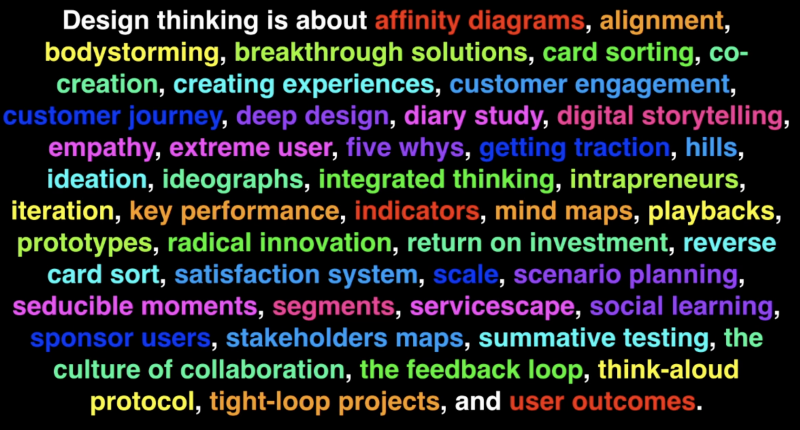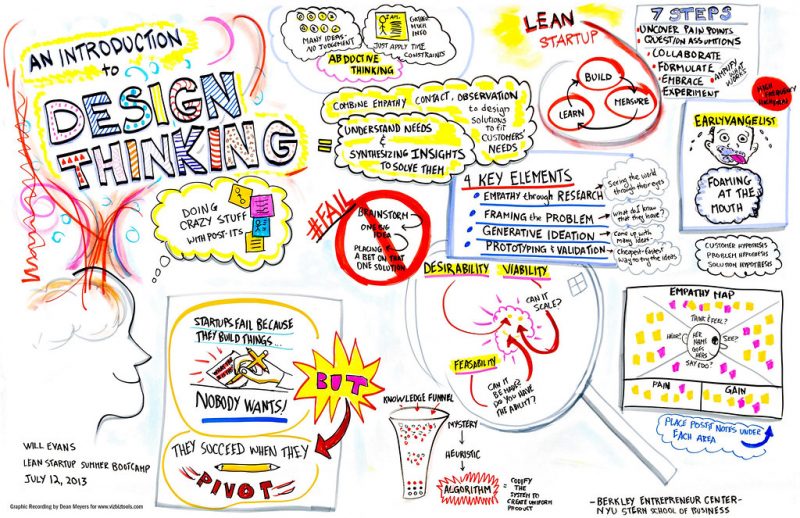The Harm of Corporate Design Thinking
Posted on October 18, 2019
Natasha Jen’s Talk “Design Thinking is Bullshit”
My first foray into the design world was through design thinking workshops. Design thinking, as defined by the founder of IDEO Tim Brown is “a human-centered approach to innovation that draws from the designer’s toolkit to integrate the needs of people, the possibilities of technology, and the requirements for business success.”
My company prided itself on ‘restless reinvention’. They worked alongside IDEO to create a flavor of design thinking that could be used and scaled for the profit-seeking enterprise. With our new bible in hand, we were missionaries, spreading the word of our innovative method to our old-school clients. We’d come into a room that was a sea of suits with our jeans and t-shirts and preach how sticky notes can solve all problems in just a matter of four days. Our workshops were 1-4 day sessions in which we would co-create with clients by participating in a series of activities that helped clients understand their users and ideate for them.
In theory, it seemed like a way to give power back to the users and create impactful products and services. But in practice, it was just another tool used to make the company more money. As said by Lee Vinsel in his critique of design thinking, “In the end, Design Thinking’s not about design. It’s not about the liberal arts. It’s not about innovation in any meaningful sense. It’s certainly not about “social innovation” if that means significant social change. It’s about COMMERCIALIZATION. It’s about making all education a shallow form of business education.”
Our workshop model devalued design and made it seem like it was something that could be done in less than a week. As part of our methodology, we advocated for ‘user research’ and ‘empathy’ for the end-user to our clients, but then proceed to not research the end user. In these fast-paced workshops, we created personas based on assumptions and then ideated based on those false personas. When facilitating a workshop with a car insurance company, one of the teams created a persona of a millennial that was a hipster man with a man bun who lived in his parents’ basement. For the rest of the workshop, this team ideated on how they could help this man get car insurance. If the company’s real intention was to help millennials with navigating car insurance, focusing on this fabricated character would not help them achieve it. By not creating the time or space to work with actual users, we were promoting the dominant narrative.

Dean Meyers – Introduction to Design Thinking
It would be one problem if the purpose of these workshops were purely educational, but clients often would take the insights from the workshop and then hire our company to build out the product. Thus, we were “perpetuating symbolic violence by embedding those assumptions and the dominant narrative into design” [Design as Symbolic Violence]. The people in the workshops were typically executives within their company and by working off of their assumptions, we showed that we valued their voice more than the voice of the actual end-user.
In the end, these workshops became a way to show clients that our company was hip and innovative. We were then used as a tool to sell more products and make more money.
If design thinking is really about being human-centered, then the process should not be condensed into 4 days but given the time it needs. Research needs to be a priority and not based on only the knowledge in the room. In Daniela Rosner’s book, Critical Fabulations, Rosner introduced tactics that can be used to push design from its hegemonic roots. She proposes a few questions that can be used to bring out voices that have previously been suppressed by design. These questions should be used during research and when creating research artifacts so we can avoid designing based off of assumptions.
1) “Whose individual work undermines your own? How might it inform your inquiry?”
2) “What histories of practice have been suppressed or elided?”
3) “What representations feed a prevailing design narrative? Whom do they represent?”
With these questions in mind, design has the opportunity to not be complacent in silencing voices. Moreover, it can be part of the movement to shift focuses away from profit, and look beyond the prospect of selling more product. But this can only be achieved if design is not commoditized.
-SR
Sources
Boehnert, Joanna, and Dimeji Onafuwa. “Design As Symbolic Violence : Reproducing the ‘Isms’ a Framework for Allies.” Intersectional Perspectives on Design, Politics and Power, November 14, 2016.
Ersoy, Lillian. “Why Design Thinking is Failing and What We Should be Doing Differently.” UX Collective. July 19, 2018. https://uxdesign.cc/why-design-thinking-is-failing-and-what-we-should-be-doing-differently-c8842f843b44
Vinsel, Lee. “Design Thinking his Kind of Like Syphilis – It’s Contagious and Rots Your Brains.” Medium. December 6, 2017. https://medium.com/@sts_news/design-thinking-is-kind-of-like-syphilis-its-contagious-and-rots-your-brains-842ed078af29
Rosner, Daniela. Critical Fabulations: Reworking the Methods and Margins of Design. , 2018. Print.